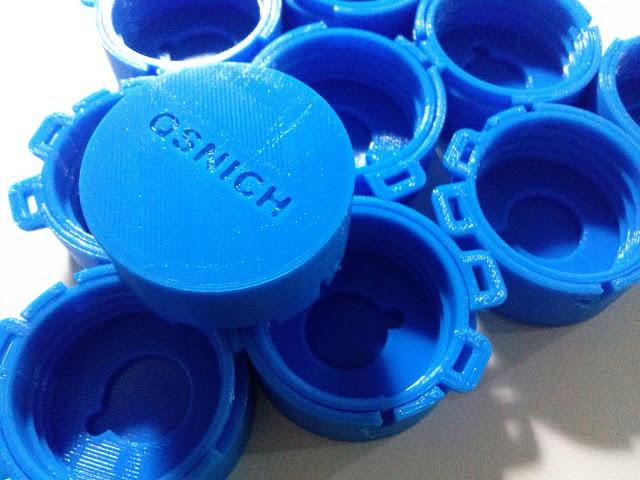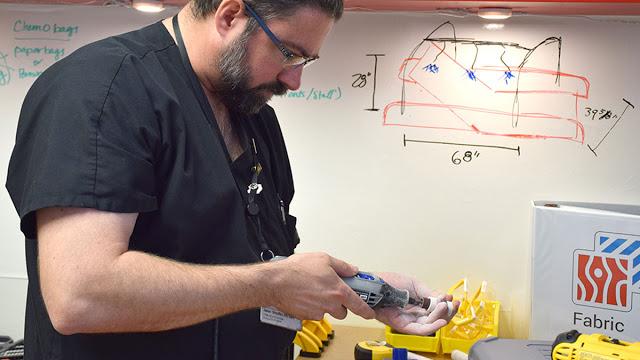Thailand’s Queen Sirikit National Institute of Child Health Encourages Doctors & Nurses to Join 3D Printing Maker Community
 In the field of medicine, the most powerful brainstorms occur, lightbulbs go off, and history is made with inventions that are dreamt up on the front lines. For sure, many researchers tucked away in labs are responsible for bringing us a wide range of amazing designs and prototypes after structured R&D, but it’s often those in the midst of seeing patients and actually performing the surgeries who realize the need for a tool or device that would assist in their job, or make a patient’s life exponentially better.
In the field of medicine, the most powerful brainstorms occur, lightbulbs go off, and history is made with inventions that are dreamt up on the front lines. For sure, many researchers tucked away in labs are responsible for bringing us a wide range of amazing designs and prototypes after structured R&D, but it’s often those in the midst of seeing patients and actually performing the surgeries who realize the need for a tool or device that would assist in their job, or make a patient’s life exponentially better.
And while we do indeed hear of one incredible 3D printed or bioprinted product after another emerging from labs around the world, from combining robotics into new medical devices such as prosthetics to bioprinting materials to aid in breast cancer research, often doctors and nurses are very involved in creating and 3D printing items like medical models to assist in tumor removals, heart surgeries, and even resulting in collections that become 3D model lending libraries for other medical professionals around the world.
 Now, a workshop at the Queen Sirikit National Institute of Child Health (QSNICH) via local makerspace ProgressTH aims to put the tools directly into the hands of doctors, nurses, and medical professionals. Completely dedicated to pediatrics, QSNICH has 450 beds and is the only hospital in Thailand dedicated to treating young patients. With 350,000 patients being seen there each year and up to 5,000 procedures performed, the hospital is committed to providing comprehensive services in their five centers of excellence:
Now, a workshop at the Queen Sirikit National Institute of Child Health (QSNICH) via local makerspace ProgressTH aims to put the tools directly into the hands of doctors, nurses, and medical professionals. Completely dedicated to pediatrics, QSNICH has 450 beds and is the only hospital in Thailand dedicated to treating young patients. With 350,000 patients being seen there each year and up to 5,000 procedures performed, the hospital is committed to providing comprehensive services in their five centers of excellence:
- The Dengue Hemorrhagic Fever Center of Excellence
- The Pediatric Cardiac Center
- The Neonatal Center
- The Neonatal Surgery Center
Their aim is to become the center of child health, and they are following a progressive plan to do so, including this latest maker workshop at the hospital, which is in Bangkok. This program is meant to supply nurses, doctors, and healthcare professionals with the tools to help the facility grow, innovate, and enhance patient’s lives. Recognizing the impact that the worldwide maker movement is having on so many sectors, but especially medical, the children’s hospital plans to start with giving those who attend the workshop a basic education in 3D printing.
Beginning with digital design and then working into 3D printing, the workshop will introduce these future medical makers to exactly what makerspaces are and what they can offer to hospitals for both making prototypes as well as putting innovative concepts into physical form. The staff at QSNICH have already been working with ProgressTH on a number of projects that could very possibly result in important tools such as:

Prototypes of a 3D printed needle disposal system have already been created at the hospital. They are being tested in larger numbers currently.
- Low-cost needle disposal system
- Dermatology tool designed specifically for children
- Blood clotting device
- 3D printer bed-leveling system
The goal ultimately will be to have a makerspace set up at QSNICH, with medical professionals trained to use 3D printers, laser cutters, and tools for rapid prototyping, making small batches of 3D objects, along with offering their own customized medical solutions on site. This will happen through a collaboration with QSNICH’s innovation department and ProgressTH, a Bangkok-based makerspace and media platform that works to connect people with technology. Their areas of interest lie in 3D design and 3D printing, as well as organic agriculture and DIY biology. The company is dedicated to organizing and promoting workshops such as the one at QSNICH, teaching others through a hands-on approach.
In working with ProgressTH, QSNICH will be that much closer to opening a makerspace inside their own facility, continuing in their mission to allow hospital staff to take innovative concepts and see them through to permanent solutions, as well as products that the hospital could possibly supply to other institutions as well. An in-house makerspace means staff have direct access to the 3D printing tools and they can, as so many others have benefited from, bring ideas to fruition quickly without a middleman.
The ProgressTH team points out that programs like this have been successful in the US, such as MIT’s MakerNurse program, an amazing study that examined how integral nurses often are within the innovative process. For Thailand, however, a makerspace in a setting such as QSNICH would be a new endeavor all around as they previously have not had the necessary resources to instill such a program with such tools.

Medical professionals have created a kid-friendly dermatology tool used for removing excess skin from patients suffering from certain conditions.
So far, the items they’ve made at QSNICH in working with ProgressTH have been replicated and are being tested throughout the hospital.
With the needle disposal system, especially, costs are significantly reduced. Originally, hospital staff were very creative in recycling plastic caps from used containers and using them as tools to remove needles from syringes. This modified cap design has now been 3D printed, and up to 50 of them will be in testing at QSNICH. It takes an hour to make one of the 3D printed devices, and the price is around $1 USD. Embracing all the benefits of 3D printing, they can be made on demand, customized at will, and are of course much more affordable.
Putting the tools directly in the hands of those working in the hospital should be an ongoing source of fascination to see what medical professionals come up with. These are dedicated talented people with bright minds, and giving them the resources to explore and innovate further in their field should not only add to the growing inventory of new products around the world, but have an incredibly positive impact on their hospital—and most importantly—their young patients. Discuss over in the Thailand Hospital Hosts 3D Printing Workshop forum at 3DPB.com.
[Source/Images: ProgressTH]Subscribe to Our Email Newsletter
Stay up-to-date on all the latest news from the 3D printing industry and receive information and offers from third party vendors.
Print Services
You May Also Like
3D Printing Financials: 3D Systems Looks to Bounce Back in 2025
After a challenging year for the industry, 3D Systems (NYSE: DDD) ended 2024 with results pointing to a reset, laying the groundwork for future profitability. The company didn’t post strong...
Printing Money Episode 27: Q4 2024 Public 3D Printing Earnings Review with Troy Jensen, Cantor Fitzgerald
Q2 2025 has already begun, but public markets reporting has only just finished with Q4 2024. To tie a bow on Q4 2024, we are thankful to have Troy Jensen...
3D Printing News Briefs & Events Roundup: March 15, 2025
In this weekend’s combined 3D Printing News Briefs and Webinars/Events Roundup, we’re covering news about automotive and construction 3D printing, along with AM Forum, TCT Asia, the Experience Stratasys Tour,...
3D Printing Software Market to Hit $6.78B Revenues by 2033
Additive Manufacturing Research (AMR) has released a new edition of its flagship market study, “AM Software Markets 2025: Analysis, Data and Forecast,” offering deep insights into the 3D printing software...


























